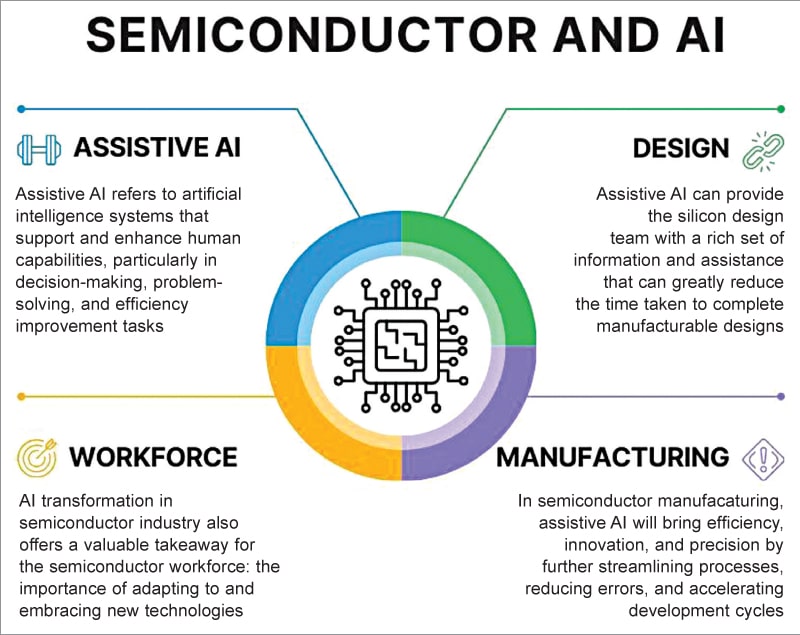Together, human intelligence and AI create a powerful synergy, highlighting the vital lesson for the semiconductor workforce: adapt to new technologies.

The relationship between semiconductors and artificial intelligence (AI) is symbiotic and transformative. Semiconductors, the backbone of all modern electronics, have played a crucial role in developing and proliferating AI technologies. At the same time, AI has increasingly influenced how semiconductor products are designed and manufactured. This mutual growth cycle promises to push the boundaries of endless possibilities in technology, leading to faster, more innovative, and more efficient products.
Building on this foundation, out of all the AI capabilities today, assistive AI emerges as a pivotal solution for the semiconductor industry, propelling it into a new era of efficiency and innovation. Also, as the complexity of semiconductor product design manufacturing increases further, with ever-smaller and ultra-advanced technology process nodes, traditional semiconductor design and manufacturing methodologies begin to falter. It is where assistive AI steps in to bridge this gap.
What is assistive AI
Assistive AI refers to artificial intelligence systems that support and enhance human capabilities, particularly in decision-making, problem-solving, and efficiency improvement tasks. Unlike fully autonomous AI systems that operate independently, assistive AI works alongside humans, providing insights, recommendations, and automation of routine tasks to augment human skills and expertise.
In various industries, specifically in the semiconductor sector, assistive AI can play a critical role by analysing complex data sets, predicting outcomes, optimising processes, assisting in routine tasks, summarising information, and identifying potential issues before they become problematic. This assistance can range from offering silicon design suggestions in the early stages of semiconductor development to optimising manufacturing processes and improving quality control on the production line. The opportunities are unlimited.
Out of all the possible positive impacts of assistive AI in semiconductor product development, the two that will stand out are:
Efficiency and productivity
Assistive AI will enable semiconductor teams by offering novel insights into different process steps. During design, it could be about capturing previously developed silicon blocks, searching through an extensive design database, and then summarising or even creating the new development blocks. After this, an experienced silicon designer can adapt, decide whether it meets market/customer requirements, and then enhance it accordingly.
Thus, overall, it will bring improved efficiency and better productivity by assisting experienced and skilled engineers by routinely taking over mundane tasks.
Learning and development
There are always problems that require revisiting the fundamentals of design and manufacturing. Instead of searching through heaps of data, an assistive AI can speedily enable domain-specific learning on the go.
Imagine a silicon designer working on a next-gen AI SoC and needing to revisit some memory and data pipeline fundamentals. Instead of going through the internet and books, an assistive AI embedded inside the EDA tool can answer all the queries, thus not only saving time but also making it more focused and domain-specific. Such a learning process will be more crucial for new hires who can on the go also develop custom learning programs based on the data presented.
Hence, it enables more helpful learning and development for semiconductor engineers.
Assistive AI workforce
Introducing assistive AI into the semiconductor workforce can often stir employee concerns about job security and the potential for AI to replace human roles. However, when leveraged effectively, assistive AI can be a powerful tool for enhancing job performance, creating new opportunities, and augmenting workforce capabilities. By strategically integrating assistive AI into their workflow, semiconductor engineers can improve their productivity and innovation and carve out new career opportunities for themselves.
How a semiconductor engineer can do it is shown in the table.
| Strategic Description | |
| Strategy | Description |
| Embrace AI for enhanced problem solving | • Learn and understand how assistive AI can help with complex simulations, analyses, and other time-critical tasks • Leveraging the ability of assistive AI to innovate can enable faster development |
| Upskill and reskill | • Engage in continuous learning of assistive AI technologies and methodologies • Acquire skills in assistive AI integration to guide design and manufacturing processes |
| Augment creativity and innovation | • Apply assistive AI to explore design/manufacturing possibilities • Identify novel solutions, leading to breakthroughs in semiconductor technology |
| Improve efficiency and productivity | • Use assistive AI to automate routine tasks • Focus on utilising assistive AI-driven insights for faster, more informed technical decision-making |
| Hands-on AI project experience | • Gain practical experience by working on assistive AI projects • This could involve using assistive AI for design optimisation, process simulation, or data analysis |
| Innovative business models | • Deploy assistive AI to identify and develop new business plans • Explore new services by brainstorming with the trillions of data points assistive AI has access to |
| Adapting to AI-enhanced workflows | • Be open to adapting existing workflows to incorporate assistive AI tools and methodologies • This may involve rethinking processes to take full advantage of assistive AI’s predictive analytics, automation capabilities, and decision support systems |
| Stay informed on industry trends | • Regularly follow publications, journals, and news related to assistive AI advancements and their applications in the semiconductor industry • Staying informed helps in anticipating changes and identifying opportunities for innovation |
| Promote an AI-positive culture | • Advocate for a positive perception of assistive AI within the organisation • Encourage discussions about assistive AI’s potential to enhance job performance, not replace it, highlighting success stories and potential growth areas |
| Identify AI integration points | • Analyse current engineering processes to identify areas where assistive AI can be integrated to improve efficiency, accuracy, or outcomes • This strategic identification helps in prioritising assistive AI adoption areas for maximum impact |
This strategic approach can help semiconductor engineers become assistive AI-ready, enabling them to embrace AI as a tool for advancement rather than viewing it as a threat to their careers.
Future of AI in semiconductor
In the semiconductor advancements landscape, AI is transitioning from mere participant to a core facilitator, heralding a new era of innovation and efficiency. Assistive AI stands at the forefront of this evolution, bridging the complexities of semiconductor design and the demands of modern technology.
By integrating AI more deeply into semiconductor processes, the semiconductor industry can anticipate a significant acceleration in the pace of development and a leap towards a more intelligent, energy-efficient, and productive way to develop next-gen silicon chips. As the semiconductor industry stands on the cusp of an AI-centered transformative phase, it is getting evident that the future of AI in semiconductors is not just about enhancing capabilities but about redefining the boundaries of what is possible, making the concept of assistive AI not just an aspiration but a critical pathway to the next semiconductor technology revolution.
This transformation also offers a valuable takeaway for the semiconductor workforce: the importance of adapting to and embracing new technologies. As AI becomes more integrated into semiconductor design and manufacturing processes, professionals in the field must acquire new skills and knowledge to work alongside these advanced systems. This shift is not about replacing human expertise but augmenting it, ensuring that the workforce remains relevant and can contribute to exciting advancements. The synergy between human intelligence and assistive AI holds the key to unlocking unprecedented levels of efficiency, creativity, and growth in the semiconductor industry.
Chetan Arvind Patil, Senior Product Engineer at NXP USA Inc.














